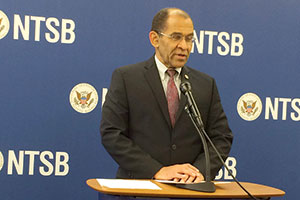Senior Reporter
Reducing Fatigue, Improving Fitness Make NTSB’s 2016 ‘Most Wanted List’

WASHINGTON — Policymakers, regulators and industry leaders need to adopt programs designed to reduce fatigue among truckers on the roads and other commercial operators to boost safety, the National Transportation Safety Board announced Jan. 13.
The independent agency’s annual “Most Wanted List” of safety concerns noted investigations of recent highway crashes determined fatigue as the likely cause, key factor, or among the circumstances that led to fatal accidents on highways.
NTSB proposes addressing fatigue by calling on commercial carriers to equip their vehicles with electronic logging devices that accurately collect data on a driver’s hours of service. The Federal Motor Carrier Safety Administration announced, in December, a requirement for carriers to use electronic logging devices to record hours of service. Carriers have until December 2017 to comply.
Also, companies should establish risk-management programs and monitor their effectiveness in reducing fatigue-related accidents. The programs should include educational workshops, medical screening and rest areas for employees, the agency noted.
“Fatigue and medical fitness for duty are also multimodal con¬cerns that take their toll not only on highways, but throughout all transportation modes. The basic problem here is that most commercial transportation is 24/7 but humans are not,” NTSB Chairman Christopher Hart said.
Asked about an ongoing study by FMCSA on the suspended 2013 HOS rules for truckers, Hart added, “The hours-of-service rules are a very critical piece of the total puzzle, and we’re looking at that as one of the many success stories from this annual ‘Most Wanted List.’ We’ve been pushing fatigue and rest and duty-time rules for quite some time. But it is only a part of it.”
A fiscal 2016 funding law directed FMCSA to report to Congress on how the HOS restart rule delivers improvements “in all outcomes related to safety, operator fatigue, driver health” and work schedules.
Under the 2013 version of the rule, truck drivers had to take off from 1 a.m. to 5 a.m. on consecutive days during a 34-hour restart. The enactment of a 2014 funding law suspended the restart rule. The suspension means that truckers have to adhere to the pre-2013 version of HOS restart.
NTSB’s list also called for safety upgrades to oil tank railcars and implementing automatic positive train control, or PTC, technology. The agency noted recent crashes, such as the derailment of a 72-car train hauling crude through Lac-Mégantic, Quebec, killing 47 people. Congress in 2008 required PTC technology be installed on freight and passenger railroads by 2015. In October, Congress extended the requirement deadline to 2018.
“Much of our rail infrastructure remains unprotected by PTC. Faced with a looming rail shutdown, Congress extended the deadline to 2018, with further extensions possible. As a result, much of our rail infrastructure remains unprotected by PTC,” Hart said. “Similarly we are concerned that the DOT-111 tank cars that are being used to transport increased quantities of flammable liquids such as crude oil and ethanol are not up to this task.”
Also making the list were calls to improve rail transit safety oversight, increase the availability of collision avoidance technologies in cars, put an end to accidents involving drug-and-alcohol impairment, expand the use of recording devices as a way of enhancing safety, prevent loss of control in flight in general aviation and require medical fitness qualifications for certain functions.
The agency said that medical certification systems for safety-critical transportation personnel would “ensure that these professionals are medically fit for duty before operating a vehicle.”
American Trucking Associations praised NTSB’s announcement.
“We always appreciate the NTSB’s efforts to shine a light on critical issues like distraction and fatigue by all motorists and the important role technology can play in improving highway safety. In addition, we appreciate the focus NTSB has on impaired driving. ATA has advocated for several policies that would address this, including the expanded hair testing language in the recently passed FAST Act,” said Dave Osiecki, ATA’s chief of national advocacy.




